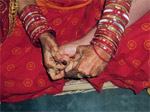
Social practices, Rituals and Festive events

Kalamkari Paintings
Kalamkari literally means, Kalam - pen & kari - work, i.e., art work done using a pen. The art of painting using organic dyes on cloth was popular in several parts of India, but this style of Kalamkari flourished at Kalahasti (80 miles north of Chennai) and at Masulipatnam (200 miles east of Hyderabad). The Kalahasti tradition which developed in the temple region depicts mainly themes from Hindu mythology, epics (Ramayana, Mahabharatha), images of Gods and heroes. The artists use a bamboo or date palm stick pointed at one end with a bundle of fine hair attached to this pointed end to serve as the brush or pen. The dyes are obtained by extracting colours form parts of plants - roots, leaves along with mineral salts of iron, tin, copper, alum, etc., which are used as mordants.
Contributed by Prarthana, CEE Ahmedabad
Kathputli - The Art of Puppetry of Rajasthan
Kathputli (kath means wood, putli means doll), the art of puppetry of Rajasthan is believed to be more than a thousand years old. It is chiefly the Bhat community that practises this art. Handcrafted in Rajasthan, the puppet's head
Kite Flying
History has it that Hiuen Tsang and Fa Hein brought the tradition of kite flying with them when they came to India in the 4th and 7th century respectively. Kite flying as a sport and pastime became popular with the patronage of Nawab Asaf-ud-daulah and his uncle Ustad Aga Abu Turrab Khan
Kaudi Khela

Kaudi Khel (Cowry Play) is one of the post-marriage ritual performed in Odisha. The groom hold one cowry (a kind of sea shell) in his hand and bride tries to get it by forcefully opening his hand. Then this happens other way around. It is a kind of fun power play to entertain the gatherings.


